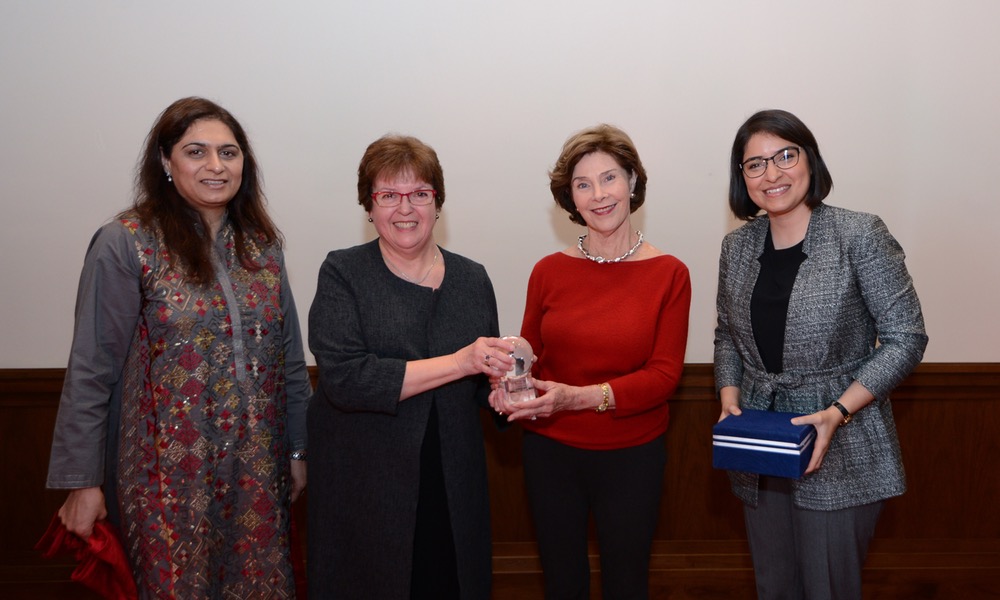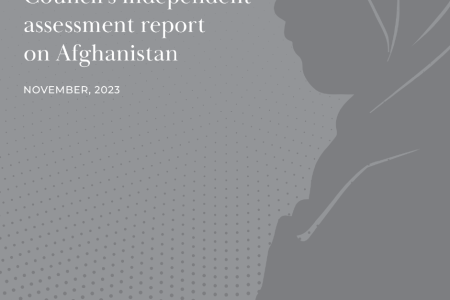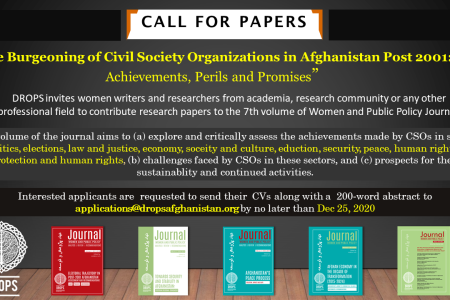November 15, 2016 7 minute Read
By the Bush Institute and the Women’s Democracy Network
On November 14, the Bush Institute and the Women’s Democracy Network at the International Republican Institute hosted a roundtable event with two women peacebuilders, Sameena Imtiaz and Mariam Safi, from Pakistan and Afghanistan, respectively. Sameena is the founder and executive director of the Peace Education and Development (PEAD) Foundation in Pakistan, and Mariam is founding director of the Organization for Policy Research and Development Studies (DROPS) in Afghanistan. We sat down to talk to Sameena and Mariam about their stories and perspectives on women’s inclusion in peace and reconciliation processes, and how women can be peacebuilders in their own communities.
What does “peacebuilding” mean to you? Was there an occurrence or incident in your life that inspired you to become active in this sphere?
Sameena: Pakistan is a diverse country. The ethnic, religious, sectarian, and political diversity has been exploited by many groups resulting in radicalization and extremism in the country. In the given context, peacebuilding for me is helping build better understanding and relations among people from diverse backgrounds – be it local, national, or regional levels. Terrorism and militancy has affected many in Pakistan including myself. My husband is a survivor of the Marriott Hotel bombing in Islamabad in 2008. My parents’ house was severely damaged as a result of the attack on the US Consulate in Peshawar in 2010; luckily they survived. Many family members and friends have in one way or another been affected by terrorism. Also, professionally, I feel that the space for progressive/liberal forces has shrunk. Radical and extremist forces are becoming stronger. Many activists including myself have been threatened and harassed by radical/extremist groups. But, believing that each one of us has the responsibility to contribute towards building peace, I have been working on various peacebuilding projects and programs since 2008.
Mariam: Peacebuilding means bringing about positive change in societies ridden by conflict. In the context of Afghanistan, this has been pursued through a range of programs focused on building local communities, human security, and building local capacities. Peace-building in Afghanistan is the process of transition from war to peace. As a student of international peace studies, I returned to Afghanistan after completing my graduate studies to work in the area of peace-building by offering a critical lens evaluating and assessing international donor and Afghan government programs. I have done this through research that critiqued and held stakeholders accountable while providing policy recommendations lodged in local perspectives and sentiments. Lack of data has been a crucial impediment in the formulation of sound policies and effective programming, and this is the gap I wanted to fill through my capacity.
You are doing important work at the national level to bring peace to your countries. How can women be peacebuilders in their own lives, or in their communities?
Sameena: Women constitute 50 percent of the population in any society and hence it is important to include them in peacebuilding processes. As caretakers, caregivers, and teachers, if trained, they can raise generations that are more tolerant, respectful, and democratic in attitudes and behaviors. As mothers, wives, daughters, and sisters, they are the first ones to see attitudinal/behavioral changes among family members. If provided adequate knowledge and skills, they cannot only monitor but also help control the extremist/radical influences on the family members. Women are also usually not considered a “threat” and hence do not receive as much attention and or resistance while building peace as men do.
Mariam: Without Afghan women’s involvement in all decision-making processes, programming, and research, efforts to bring peace would not only lack a critical gender lens but would simply be inadequate and ultimately ineffective, which we have witnessed in Afghanistan. Women can play critical roles in bringing peace by developing responses to violence and terrorism, and challenging and delegitimizing extremist narratives. The traditional roles ascribed to women in many societies, such as wife, mother, and nurturer, empower them in some instances to become custodians of cultural, social, and religious values. This enables them to challenge extremist narratives and shape the home, education, and social environments to make extremism and violence a less desirable option.
What has been the most challenging aspect of being a woman peacebuilder in Afghanistan and Pakistan? Why is women’s inclusion, specifically, so important in Afghanistan and Pakistan?
Sameena: The biggest challenge is the “mindset” of the people – both men and women – and a poor understanding of the role of women as “contributors.” Also, in the highly patriarchal and conservative society in Pakistan, men predominately are the decision makers and hence women’s inclusion remains an issue.
Mariam: The most challenging aspect of being a woman peacebuilder in Afghanistan is that while on paper the government has signed onto the National Action Plan for the Women of Afghanistan, women ultimately do not have an enabling environment to actually carry out the responsibilities bestowed onto them in these documents. Lack of implementation sustained by a lack of political will, combined with a growing phenomenon of cultural conservatism, have all come together to prevent the establishment of such an enabling environment. Furthermore, while women in the government or in civil society organizations are more aware of the role they can play as peacebuilders and have the right tools to do so, women at the community level need to be continuously provided with capacity-building on peace-building tools which should be framed within their local context using mechanisms they are already familiar with.
http://www.bushcenter.org/publications/articles/2016/11/perspectives-from-women-peacebuilders-in-afghanistan-and-pakistan.html



